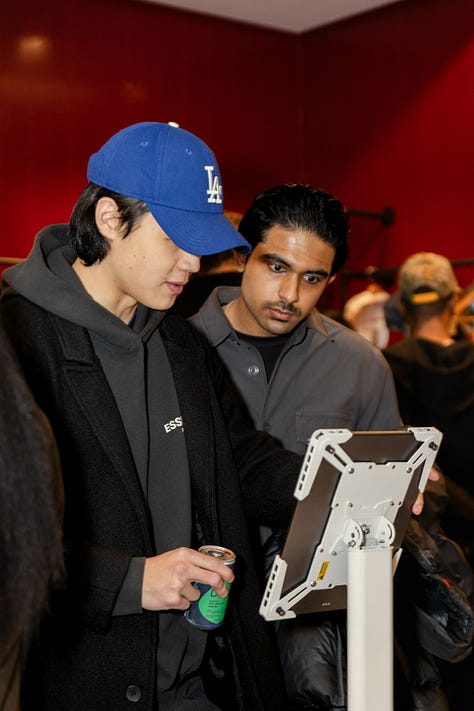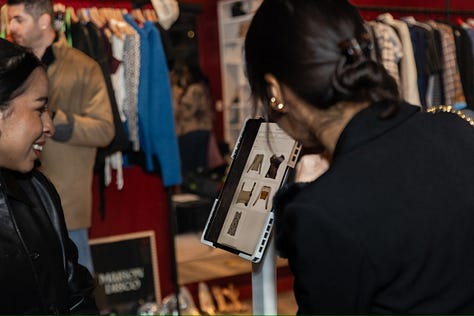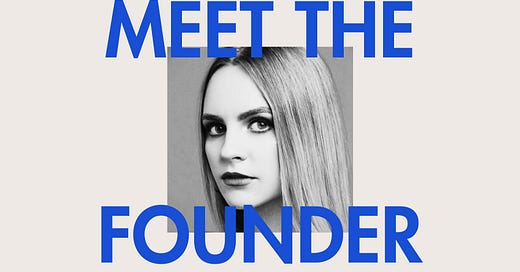Founder Spotlight: Sean Sinko, ThredX
How Virtual Try-On Pioneer Sean Sinko’s company ThredX is Revolutionizing Fashion with Their Physics-Based Technology
Team,
The name "The Pattern Maker" was born as a challenge to the common tech investors habit to “pattern match” - funding familiar faces and ideas - at the expense of genuine innovation.
In this spotlight series, I’ll be introducing you to the founders, investors and fashion leaders I believe are challenging the status quo and actually delivering innovative solutions for fashion.
These aren’t just Q&A interviews, these spotlights will include mini-market memos and share the insights these experts have gained from hundreds of hours in the trenches. I hope we can create new patterns for success through this series and inspire more innovation in fashion!
Let’s get into it.
Do you know a startup founder building something interesting? Let me know in the comments who I should spotlight next!
Meet Sean Sinko, the CoFounder and CEO of ThredX
Though I’ve known and admired Sean for a while now — I was first introduced to ThredX back in February 2024 when I was a panelist for the first EDGE expo in NYC — we more formally hopped on zoom early this year so I could finally dive into the details of her company, how she became a founder, how she’s thinking about the future for ThredX and fashion as a whole, and to get her insider intel on virtual try on.
As Sean told me, “whoever can have the best and most efficient virtual try on experience in terms of realism and [low] latency, will be the winner” and that’s exactly what ThredX is building for the industry.
Here’s what can you expect from this spotlight:
Virtual try on - what’s the landscape, who’s the major players, what’s the history
An overview of Sean’s company ThredX and ThredX Shop, and what makes them different
Sean’s journey from styling to founding a deep tech company
The early days going from an idea to partnerships with brands
Sean’s thoughts on why partnering with emerging brands is the move and other musings and lessons learned for early stage founders
Virtual Try On Mini Market Memo Overview
First, let’s set the scene. Sean is building in a category called “Virtual Try On” (VTO). More specifically, they’re in the business of giving consumers the ability to virtually try clothes on a digital twin or avatar of themself (or of a similar body type) that makes it easy to visualize yourself in the clothes or full outfits.
Note, this is different from fit tech or body scanning tech (Ex. TrueToForm, 3DLook, Fit:Match) which is related but does not create a digital rendering of the garment to visually see “on you”.
Augmented reality technology (AR) is another flavor of VTO common especially in related categories like beauty (ex. ModiFace) and accessories (ex. Tangiblee). However, for apparel, beyond a few companies (ex. Wanna), digital twins seem to be preferred over AR.
The uses cases for VTO are numerous but three examples that draw the most attention are:
Consumer closet management apps: creating outfits from what you own or with clothes they’re considering purchasing
Ecommerce feature: feature integrated in the product page allowing customers to see the clothes on their own digital twin
Retail tablet for extended sizing and custom: an ideal solution when your size isn’t available in store or for smaller brands with fewer SKUs or less ready-to-wear inventory.
VTO is exciting because it has the potential to reduce return rates (currently at 30% for online clothing purchases, Radial), increase utilization of our clothes (US consumers on average wear their clothes less than 10 times before discarding, Earth Org), improve online engagement (Dior saw a 6.2x ROAS with Snap powered VTO, Fashionista), and reduce production waste.
Virtual try on tech has been in development and discussed in the fashion tech space for at least the past 20 years. Some of the historic players like Fision (aka Meepl), Zeekit and Drapr were all bought in a flurry of VTO excitement and M&A activity in 2020/2021: Zalando acquired Fision, Walmart acquired Zeekit and Gap acquired Drapr.
Today the main players in the space include Doji, DressX, Zakeke, Reactive Reality (PICTOFiT), and, of course, ThredX.
The inside scope: VTO tech is still bleeding-edge
When chatting with Sean about the state of virtual try on, it was interesting to hear that despite impressive demos or big M&A activity, across the board the tech still misses essential functionality that consumers can innately perceive even if they can’t alway articulate it. In fact, when Sean started ThredX in 2020, she intended to partner on the tech and specialize on the consumer experience but none of the existing solutions met expectations.
“Especially in fashion, designers are so detail oriented… So the quality of the virtual try on experience has to be high from a design standpoint and then the actual tech experience — the realism, the latency, and, the ability to interact with the try on experience — has to be seamless so the customer has a positive experience with it. Even today, this is still bleeding-edge technology.”
ThredX is one of the leading virtual try on technologies thanks to the team's obsession with providing a virtual try on experience as realistic and fun (if not more) as trying clothes on IRL.
What’s ThredX?
ThredX has built the technology and platforms that allow users to take a standard picture of a clothing item and make it a digital object, so that it can be virtually tried on. More specifically…
“ThredX” is a consumer app that allows users to virtually try on items in their closet — making it easy to style what they own, decide what to resell, and take better control of their wardrobe. Join the waitlist HERE to be the first to access the app.
“ThredX Shop” is ThredX’s newest offering for brands to integrate virtual try on directly into their digital or retail shopping experience by taking existing product images and creating digital versions consumers can “try on” before buying. Want to shop with virtual try on? Download ThredX Shop HERE to test the experience.
With these two touch points - the consumer app and virtual try on shopping experience - Sean and team are creating the data layer that is the foundation for what they believe will be the next generation of interaction between us and our clothing in a digital space.
They launched ThredX Shop in early this year and already are operational with 20+ brands! If you’re an emerging brand or designer looking to give virtual try on a run, reach out to Sean and team at hello@thredx.co.
What makes ThredX different?
The difference between ThredX and other competitors is how they’ve built the technology that converts images to digital objects and Sean's unique styling background.
As Sean described, “we have developed our own proprietary system grounded in physics and human proportions”, as opposed to leveraging GenAI or other commonly used methods that they’ve found do not accurately represent the clothes.
Sean continued, “Many virtual try-on providers today rely solely on generative AI within their process, but we’ve found that gen AI alone has trouble preserving the human form while maintaining key details like texture, fit and spatial fidelity… It also can introduce long load times that break the flow of the experience.” (Sean shared these great reads for those looking to go deeper Article 1, Article 2, Article 3)
These points are a big deal when it comes to adoption of virtual try on because ultimately it’s table stakes that virtual try on is additive and not disruptive to the shopping experience.
Rachel’s note: I think this approach is smart, because although GenAI is hot right now and can make realistic looking products and images, if it’s not actually realistic and customers make purchases of an essentially fake product, the reputational damage and erosion of trust will be severe for brands.
Beyond the technical differentiation, Sean’s background as a stylist means no one understands better than her the nuances involved in putting together a look. Everything from how clothes and materials layer together to how a slight tuck or rolled sleeve can change the look. That’s why having a founder who can articulate these nuances and a technical cofounder and engineering team dedicated to solving the highly complex task of translating these nuances to the digital world, is setting ThredX apart.
What led Sean to building ThredX?
Sean’s journey to founding a deep tech company for fashion came from her own personal experience as a stylist early in her career.
As a stylist she was working with clients and different fashion retailers styling outfits on models and taking social media and e-commerce pictures. She eventually expanded to styling at a photo studio as well as her own clients where she would go to their homes, style the clothes in their closet and buy items to fill wardrobe gaps.
That’s when she originally thought, “there's so much inefficiency within the fashion space because everything is physical. I had to run to the store to get clothing, bring it back, have the client try it on, and then I'd return it. This process of working with clothing was really labor intensive.”
From there, Sean ended up working for a telehealth tech startup in Silicon Valley in 2019 and watched it grow from 16 to now 550 employees, scaling healthcare all through their digital software. That’s when she realized she could do the same to eliminate the aforementioned inefficiencies in the fashion industry in a scalable way.

How to go from 0 to 1 in Fashion Tech
Once having the realization that there was a way to eliminate the physical inefficiencies of fashion through software, here’s how Sean went from 0 to 1, taking steps I would recommend to any consumer tech founder…
Step 1. The Scrappy MVP
“I started with my personal closet…[I] was taking pictures of my items and then photoshopping it to my body, and changing the layer to be able to create outfits. That's actually what we started scaling originally, without even thinking about AI at all. Then people were paying me to create these photoshop documents for them. That's when I thought ‘okay, this is obviously solving a problem. Is there’s a way to automate what I'm doing?’”
Step 2. Building the Waitlist
“I got those initial customers just through posting on social media. I started by posting on Snapchat and Instagram … and by talking to people within the industry. They kept signing up and then we started bringing people on to Beta test.”
Once they had a basic tech prototype (app with some back end automation and a basic UI) they were able to do testing with a few hundred users already in 2023!
Step 3. Early Results
“We did a 6 month Beta and ~72% of people used the app every week the whole 6 months. When they were opening the app it was for 9 minutes on average where they were playing around with the app… I found that to be so valuable and fulfilling to know that we were getting people to think more about their closet.”
Step 4. Refining the Business Model
After the Beta, Sean realized that customers were clearly interested in having a digital version of their closet and saving outfits but the D2C business model would be difficult. Consumers would have to pay which Sean felt was too much to ask on top of adding all their clothes to the app because the other common answer of a “data play” that lacked clarity.
Rachel’s Note: “and then we’ll sell the data” is a common claim founders make when trying to figure out their consumer business model. Without a clear buyer and understanding of how to monetize that data, this isn’t a real business model and can come across as a copout. It’s important for founders to recognize that if selling the data down the line is the only viable way to generate revenue, it’s time to pivot.
Step 5. Doubling down on what’s working to fuel the larger vision
Seeing the techs performance with customers, Sean then went to the brands who showed a clear interest in digitizing their collections for customers to engage with and “try on”. By starting with brands, this enables the team to build the business, refine the tech alongside the designers and brand owners and develop consumer familiarity that collectively can support a return to D2C in the future if they choose.



Why Partnering with Emerging Brands is the Move
My favorite insight coming out of my conversation with Sean is how she’s thinking about her ICP (ideal customer profile). It’s common in fashion tech to want to partner with the biggest most well known logo you can put on your traction slide. But Sean thinks about it differently.
With big brands, they’re often bloated with a ton of SKUs, run on low margins and have several layers of bureaucracy that can be a death sentence for startups without endless runway.
That’s why ThredX has centered on luxury emerging designers. Here’s Sean’s reasoning:
“They’re very open minded, they're trying out new things. It's a small team so they don't have so many checkpoints.”
“They're a good test group because they're more willing to try things, see if it works and work with you.”
“They're also looking for community and eyeballs on their work.” making these relationships mutually beneficial.
“It gives you the ability to hit KPIs which will drive your ability to partner with larger brands” if that’s still the goal.
“They’re the real future of fashion. Because technology is moving so fast, I truly believe that emerging designers, and custom fashion are going to skyrocket with this new technology.”
When I asked her how she thinks about revenue and partnerships (what I feel is seen as the challenges to partnering small), she shared this advice:
Find people who have a business mind and are trying to grow so you can grow with them.
You need to be collaborative from a pricing standpoint, but you should be able to trust that they can pay even if it’s discounted to start.
You need to be considering longevity and believe that their designs are unique. This is where an eye for fashion is important.
Talk with the founder, understand their story, how long they've been working on their brand, and how they’ll scale. Approach it like an accelerator identifying companies to invest in.
What’s next for Sean and ThredX?
With live partnerships already transforming the shopping experience for emerging designers, Sean and the team are now focused on scaling ThredX’s technology across retail environments — from bridal boutiques and fashion showrooms to e-commerce platforms looking to level up the customer experience.
Early adopters of virtual try-on have already seen up to 30% increases in sales, 64% reductions in return rates, and conversion rates up to 90% higher than traditional e-commerce.
If you’re a brand exploring how AI can streamline your backend, design, sales, or content workflows, reach out— Sean would love to hear what you’re building and see where ThredX may be able to help.
If you want to try ThredX for yourself, download the ThredX Shop app.
And if you want to follow along with the ThredX journey, you can find more information at @thredx on Instagram, www.thredx.co, or follow along with company updates on Linkedin.
Have you tried virtual try-on technology? I'd love to hear about your experience in the comments! And if you know a founder revolutionizing another aspect of fashion tech, send their info my way for potential future spotlights.
The Pattern Maker








This was a great read! Thanks Rachel!
Really enjoyed this breakdown on ThredX, Rachel. Very precise and clear storytelling! Love what Sean's building at ThredX, and thank you for sharing the mini market map. Tons of new VTO companies are now on my radar.